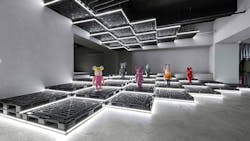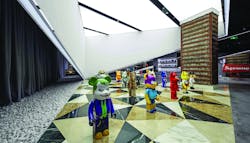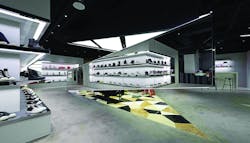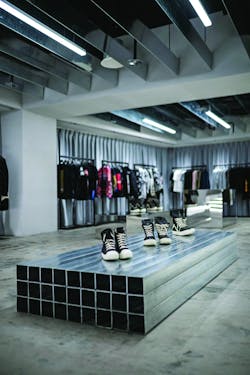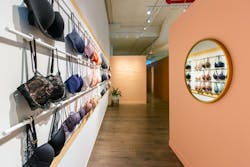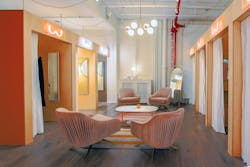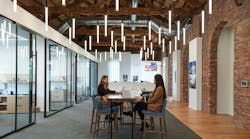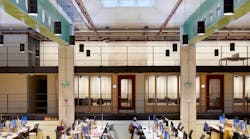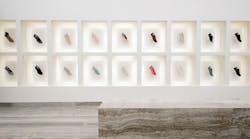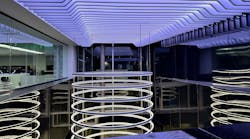With the convenience and unparalleled product selection available to online shoppers, companies are rethinking their approach to retail, seeking ways they can entice customers to visit their physical stores.
This repurposing is causing a shift in retail store design, and the way lighting is used in these spaces is changing. The approach once well-executed by major department stores—where merchandising displays drove buying decisions—is being replaced by retailing that reflects consumer lifestyles, interaction, a feeling of community, and visually stimulating environments.
The three stores featured here each demonstrate this shift to solution-based lighting. ThirdLove, a Direct-to-Consumer disruptor in the lingerie industry, has adapted a salon image for their pop-up shop and sought to use lighting that would flatter customers in the fitting rooms. In Shanghai, the By Experimental Store was specifically designed to appeal to the sensibilities of Gen Z. In Target stores around the country, illuminated elements are being used to define a special Ulta Beauty shop-in-shop area designed to elevate the beauty buying experience.
Illumination that connects to Gen Z sensibilities
When the design firm Spacemen was awarded the contract to design the By Experimental Store in Shanghai’s Soho Fusing Plaza, lead designer Edward Tan knew it was a good fit. “We welcome opportunities to transform brand ideologies into one-of-a-kind spatial experiences that tell stories.” Their challenge for the 8,800 sq. ft. store was to create a space that would be constantly shifting and evolving, part retail, part gallery.
By is targeted directly at Gen Z, which refers to people born between 1997 and 2012. “The owners understood the culture their audience wanted to be associated with, and the job for us was to create a store to match,” said Tan. China’s GenZ consumers have cultivated unique consumption habits, which create opportunities for new start-ups. Recent estimates identify this group as accounting for 27% of the Chinese population. In Shanghai alone, there is a potential local urban market of approximately two million Gen Zs.
Tan and his team researched the psychology of Gen Z. “They want something that is different from the previous generations and also want something that is an expression of their values,” he said. “Creating a community is all-important. People get together within shops and want to find venues where they feel comfortable. Exhibitions are already a core driver. In this new aggregation format, retail is one part of the business to attract young consumers,” explained Tan.
The interior design is playful and eclectic. Spaces could be used for displaying menswear one day and, on the next, showing a collection of stand-alone character toy figurines. Flexibility of the lighting program was a critical factor in supporting the architecture and the space’s dual role as trend product merchandiser and art display environment.
Triangular tiles in the flooring details are echoed in the overhead lighting. The triangular shape is repeated by a floating, illuminated Barrisol-covered frame. Black display risers are outlined with light, while above, the same units are fitted with a rim of small luminaries. Angled free-standing footwear and accessories display units are backlit. Suspended strip fixtures illuminate floor-mounted reflective displays and rack-hung garments. A single chandelier hangs in the bar area.
In a post authored by Tan and published on Retail Design Blog, he describes the experimental space in this way. “The chameleon-like angular display alcove that seemingly disappears as it is camouflaged by reflections of its surroundings and an ever-changing installation of 600 recycled pallets anchor the space. Deconstructed fitting rooms have light installations inside and mirrors on the outside to encourage the selfie generation to capture the perfect outfit-of-the-day (OOTD) snaps while they are changing.”
Defining new spaces within a store
The retail powerhouses Ulta Beauty and Target have combined their vast knowledge of beauty and merchandising to offer customers next-level, in-store beauty merchandising. “Our collective brands and expertise will raise the bar for the beauty shopping experience,” said Cassandra Jones, Target’s vice president of beauty.
The result of this collaborative venture will be a 1,000 sq. ft. island inside 100 Target stores that represent a creative and updated version of the traditional “shop-in-shop” concept. The goal was to make guests feel truly immersed in the worlds of both Target and Ulta Beauty.
Design of this ultimate beauty shopping space was a collaboration of in-house merchandising and design staffs to establish the materials and color palettes. Ulta Beauty’s signature orange pop canopies with integrated lighting are one of the key design elements being used to visually distinguish this as a special beauty area. Shielded strip LEDs are placed within the rectangular canopy slats, mounted so they are out of the customer’s sight lines. Overhead is the store’s ceiling with ambient illumination from shielded surface-mounted square and strip fixtures.
Jones credits Target’s “strength in visual merchandising” and lighting design expertise for establishing the section’s dynamic merchandise presentation style. The standing and hanging canopies are identifiable from distances throughout the store to pique interest and invite shoppers into the space.
Lighting that flatters in a fitting room
When the management of ThirdLove, the online lingerie retailer, sought to open a pop-up store in New York’s SoHo district, they presented architect Alda Ly Architecture and Focus Lighting with their design brief. It had four important objectives: fast-track design and construction; make it open, comfortable, and inviting; create an outstanding retail store on a limited budget; and use colors and lighting to flatter the customer and the products.
“Sure, we can do that,” responded Brett Andersen, partner and studio director for Focus Lighting. San Francisco-based ThirdLove had, in six years, become a public company with an annual sales volume approaching $95 million. Founded by former Google executive Gloria Zak, the company became a disruptor in an industry where marketing changes come few and far between.
For the dressing rooms, Andersen and his team decided to concentrate on the Philips Hue line of wirelessly controlled color-changing fixtures and lamps. In their large studio space, Focus built a mock-up of a dressing room and experimented with different color outputs from the lamps and placement. “Many ordinary dressing rooms have a single overhead light that causes shadows and does nothing to flatter skin tones,” he points out.
The performance of the Philips Hue lamps met their design intent. “These are widely available products used primarily for residential purposes, but for us, they were fine, considering the constraints on the project,” Anderson explained. “We visited local stores and bought what we needed to avoid any delays in out-of-stock wholesale inventories or shipping.”
In the showroom, existing track fixtures for PAR 30 and PAR 38 were used with new screw-in LEDs. Unlike most retail underwear displays, with crowded shelving and free-standing tables and pedestals, sample products at ThirdLove are displayed on a single wall on hang bars. Associates use back storage to obtain selections for customers to try on.
Above each fitting room, Focus adapted a color-changing signal to bend into a boob-shaped outline. Customers in the fitting room can change the color of the fixture to signal a sales associate to assist with changing size or styles.
A chandelier with a cluster of circular white opaque fixtures introduces a residential lighting feel to the waiting areas furnished with stylish chairs grouped around a low cocktail table.
This article appeared in the March 2022 issue of Architectural SSL magazine.
